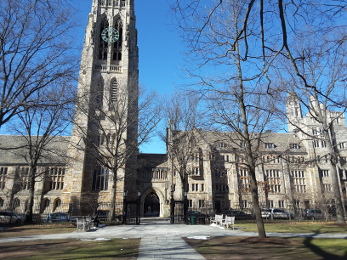Accountability
College – who needs it?
College in America today is the most overrated and expensive benefit a government can grant. Is college actually worth four years? How to tell.

College – its cost, tremendous student loans, and its value – now is a major Presidential campaign issue. Senators Bernard Sanders (I-Vt.), Elizabeth Warren (D-Mass.), and others promise to cancel student loan debt, at least in large part. The time has now come to re-evaluate college, and the notion of college for everyone.
Promises, promises about college in 2020
Senator Elizabeth Warren (D-Mass.) promises
to forgive 95 percent of student loan debt tax-free. She also would
make all “public colleges” (typically Universities of
Such-a-State) tuition-free.
No other candidate promises to be this generous with taxpayers’ money, although some (like Senator Bernard Sanders, I-Vt.) come close.
In the immortal words of the late Ayn Rand, who pays for this largesse? Blank-out. Where, indeed, does the conscientious alumnus go to claim the benefits on which he missed out? Will the government now have yet another insolvent insurance plan, similar to the Old Age, Survivors and Disability Insurance Plan we miss-call “Social Security”? When, actually, will the American people recognize the endgame: government running everything, deciding who works where, who lives where, etc.?
Why college?
The popular financial adviser Jane Pauley, in a video she recorded for Intuit’s Quicken program, once described three reasons to borrow money:
- Go to school.
- Start a business.
- Buy a house.
She based that notion on a simple maxim: you borrow against future income and/or savings. This could be the savings from managing your own domicile and its expenses. (A renter lets someone else take care of such things, from taxes to lawn mowing.) Furthermore, a house “hedges” one’s worth against inflation. Equally obviously, a new business will bring in more income, so the borrower can pay the loan back.
This same rationale used to apply to college. But today it does not. Why not? Because too many people are going to college either:
- For the wrong reasons, or
- In totally unrealistic job expectations.
What can one expect after college?
The income one can expect after college depends on two things: the “major” and the jobs available in it. John Harvard founded the college that bears his name in 1636. He sought to educate students for the ministry. Sixty-five years later, Elihu Yale would found a college bearing his name for much the same reasons.
Of course, college, and especially university, prepares students for far more than ministry. But at least before the War Between the States, one college attracted the sons of the elite more than any other. That college was the United States Military Academy—West Point.
Today one can group “majors” into four areas, as Yale College did in the Seventies when your editor attended:
- Languages, both English and “foreign.”
- The rest of the humanities.
- Social sciences (psychology, sociology, political science, etc.).
- Natural sciences and mathematics. Or to use a more inclusive term, Science, Technology, Engineering and Mathematics – STEM.
Different majors, different prospects
So for what kinds of jobs do these major groups prepare their students?
All areas prepare their students for eventual careers as professors or instructors at college and university. The Ivy League probably sends its alumni to all other faculties, or close to it.
Failing that—and most students on the academic track will fall off that track—what other jobs exist?
Foreign-language majors might look for careers in the government intelligence services. Or a student having a degree in an especially popular foreign language might go into business (with or without a Masters in business) and seek to join the international division of a Fortune 100 company.
Majors in other humanities can look forward to obtaining curatorships or assistant curatorships in museums. A job actually doing archaeology, anthropology, etc. is a faculty job. Rarely does a museum, even of natural history, employ its own hands-dirtying staff. They leave that up to university departments in the relevant areas.
A warning to the art and music majors
Two major exceptions (pardon the pun) exist: applied art and applied music. Even so, lucrative careers are rare. People do not appreciate truly good, stand-the-test-of-time art or music today. Who can honestly compare the great operas of Gioacchino Rossini and Giuseppe Verdi to popular music today? (Although an extraordinarily fortunate composer might achieve greatness working with equally great motion-picture producers and directors. Consider John Williams’ career with George Lucas and Stephen Spielberg, or Bernard Hermann’s career with Sir Alfred Hitchcock.)
Social-science majors can go into either law or (especially in psychology) clinical practice. The exception: economists, who might work for some Fortune 100 or maybe Fortune 500 companies.
From which STEMs the glory
By far the most rewarding major area, and with the best promise of any kind of reward, is STEM. A major in STEM can choose among the following very lucrative careers, without limitation:
- Medicine.
- Invention.
- Any of the engineering disciplines.
- Architecture, a curious blend of art and engineering.
- Flight sciences.
These are, by and large, not faculty positions. In fact, except for medicine, a typical STEM major can make more money outside the academy than within it! (And even community medicine is but a small step down from academic medicine. At least, to a non-medical worker or professional.)
Why college costs so much
College tuitions and fees have risen beyond any rational estimate, especially since the Sixties. Any economist (so far) could tell you why: supply and demand. The supply of college still has its limits. Then with the GI Bill and especially Fulbright Scholarships, Pell Grants, and loan programs, more people sought out college. And colleges and universities did what any businessman would do when customers flocked in with guaranteed third-party payment plans. They raised their prices.
More recently, they started to “compete” on the luxury they could offer in the area of student life. This especially applies to residential life. In your editor’s day, four years at Yale College meant living in an ultra-efficiency apartment in a centuries-old building. And with steam heat at that, and no air conditioning! Television? One TV set in a basement common room, with one antenna, and snowy reception on every channel but one. The Internet did not yet exist, of course.
Today all students have cable and/or streaming TV available at all hours. Forced-air HVAC has replaced steam heat in every dormitory building. (That particular renovation program lasted for twelve years, after which Yale built two more residential colleges.)
An expensive spa
No wonder college costs so much today—running to six figures in a four-year course of study! And during his studies, the student doesn’t care. In fact, he doesn’t especially want to leave! Who would want to leave? Even “The Villages” in Florida should offer such luxury to their tenants! Free meals always available (except for the fall of 1977, when the dining hall, janitorial, and other staff went on strike, during which time your editor repaired to Naples Pizzeria on New Haven’s Wall Street). And, of course, everything close enough together that the only transport one needed was a bicycle.
And every weekend at least, every classroom building would turn into a theater to show a syndicated movie.
That’s all very well. But who pays for that? Blank-out! Your editor’s family laid enough by to pay for two years at Yale, after which they used current funds. No family, even making as much (adjusted for inflation, even!), could do that today!
Let’s be practical
So what practical solution presents itself? First, to recognize that college is not for everyone. Only with “platinum” connections will any alum get a faculty or museum or spy agency job. A very good classical musician might make a go of it. But one must go to a specialty college like Julliard or Eastman. And for applied art? Don’t major in art; minor in it. Then use it to go to work for an ad agency or a Fortune 100 company. There you can design their logos and even some of their products.
The most cost-effective way to use a college education is to:
- Excel in your science and math classes (and other major areas, too) and earn advanced standing. Which means: acceleration credit when you reach college. The best classes to take are Advanced Placement courses, named for the College Board Advanced Placement Exams.
- Major in STEM.
- Cash in your acceleration credits and get your degree in three years, not four. And at some institutions, take advantage of combined-degree programs.
You will save twenty-five percent of the cost of a bachelor’s degree. More than that, you will save time. Then you can get the high-paying job that will pay off your student loan in record time.
What about those promises?
Now about those promises from the Democratic Party and its most likely winners: those promises are empty. The only way to make them pay is through the New Monetary Policy of Representativa Alexandria Ocasio-Cortez (D-N.Y.). She actually proposed printing more money to pay for anything. That way lies hyperinflation.
So CNAV recommends but one answer: NO. Enn-Oh, NO. Relegate the person who proposes that to the dustbin of history. Such a person is lucky at that. Anyone promising so much more than he could possibly deliver, would face arrest for fraud.
And what about student loan debt? Let others investigate whether any causes of action exist for what amounts to thoroughly bad advice. They who gave that advice should pay, not the taxpayer.
Eventually, as only those who can truly benefit from college seek it out, tuition will fall. Supply and demand still rule.
About the image
The Edmund S. Harkness Memorial Clock Tower stands between Branford and Saybrook Residential Colleges, part of Yale College. This original image belongs to CNAV.
Terry A. Hurlbut has been a student of politics, philosophy, and science for more than 35 years. He is a graduate of Yale College and has served as a physician-level laboratory administrator in a 250-bed community hospital. He also is a serious student of the Bible, is conversant in its two primary original languages, and has followed the creation-science movement closely since 1993.
-

 Civilization5 days ago
Civilization5 days agoIlhan Omar Did Not Flee From Oppression As A Refugee – She Was Fleeing Justice & Has Been Installed To Attack – This Video Speaks Loud & Clear
-

 Guest Columns4 days ago
Guest Columns4 days agoShe Saved Her Life. 7-Eleven Fired Her
-

 Civilization5 days ago
Civilization5 days agoThis Thanksgiving, Celebrate the New Beacon of the American Dream
-

 Civilization4 days ago
Civilization4 days agoDemocrats’ Viral Video Lights Match to the Republic
-

 Guest Columns3 days ago
Guest Columns3 days agoWaste of the Day: What’s Big, Grey And Costs $350K?
-

 Civilization3 days ago
Civilization3 days agoThe AI Challenge: Palantir, the Pope, and Paul Kingsnorth
-

 Civilization3 days ago
Civilization3 days agoNo Kings, No Queens, No Blind Loyalty
-

 Executive2 days ago
Executive2 days agoWaste of the Day: California’s $450 Million 911 Center Doesn’t Work













[…] readers of this site will recall your editor’s earlier essay, College – Who Needs It. The answer is: not everyone. “Wages in many cases are higher,” Bernie Sanders tells us. But […]
[…] to this pass by wrongly deciding that everyone should have a shot at going to college. News flash: college does not benefit everyone. CNAV has gone over this before – nearly three years ago in fact. The reason we covered it then […]
[…] more than three years ago, pointed out that college will not benefit everyone who goes to it today. Ninety-five percent of college […]